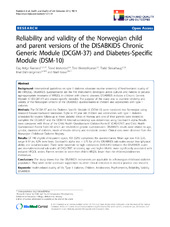| dc.contributor.author | Frøisland, Dag H. | en_US |
| dc.contributor.author | Markestad, Trond | en_US |
| dc.contributor.author | Wentzel-Larsen, Tore | en_US |
| dc.contributor.author | Skrivarhaug, Torild | en_US |
| dc.contributor.author | Dahl-Jørgensen, Knut | en_US |
| dc.contributor.author | Graue, Marit | en_US |
| dc.date.accessioned | 2013-05-24T08:41:59Z | |
| dc.date.available | 2013-05-24T08:41:59Z | |
| dc.date.issued | 2012-02-02 | eng |
| dc.Published | Health and Quality of Life Outcomes 2012, 10:19 | eng |
| dc.identifier.issn | 1477-7525 | |
| dc.identifier.uri | https://hdl.handle.net/1956/6653 | |
| dc.description.abstract | Background: International guidelines on type 1 diabetes advocate routine screening of health-related quality of life (HRQOL). DISABKIDS questionnaires are the first instruments developed across cultures and nations to provide age-appropriate measures of HRQOL in children with chronic diseases. DISABKIDS includes a Chronic Generic Module 37 (DCGM-37) and disease-specific modules. The purpose of this study was to examine reliability and validity of the Norwegian versions of the DISABKIDS questionnaires in children and adolescents with type 1 diabetes. Methods: The DCGM-37 and the Diabetes Specific Module-10 (DDM-10) were translated into Norwegian using standard forward-backward translation. Eight to 19 year old children and adolescents with type 1 diabetes scheduled for routine follow-up at three diabetic clinics in Norway and one of their parents were invited to complete the DCGM-37 and the DDM-10. Internal consistency was determined using Cronbach's alpha. Results were compared with those of the Child Health Questionnaire Children Form-87 (CHQ-CF87) and Child Health Questionnaire Parent Form-50 which are established generic questionnaires. DISABKIDS results were related to age, gender, duration of diabetes, mode of insulin delivery and metabolic control. Clinical data were obtained from the Norwegian Childhood Diabetes Registry. Results: Of 198 eligible child-parent dyads, 103 (52%) completed the questionnaires. Mean age was 13.6 (2.6), range 8-19 yrs, 52% were boys. Cronbach's alpha was > 0.70 for all the DISABKIDS sub-scales except two (physical ability and social inclusion). There were moderate to high correlations (0.65-0.81) between the DISABKIDS scales and mental/emotional sub-scales of CHQ-CF87. Increasing age and higher HbA1c were significantly associated with reduced HRQOL scores. Parents tended to score their child's HRQOL lower than the children/adolescents themselves. Conclusions: The study shows that the DISABKIDS instruments are applicable to a Norwegian childhood diabetes population. They seem to be a relevant supplement to other clinical indicators in medical practice and research. | en_US |
| dc.language.iso | eng | eng |
| dc.publisher | BioMed Central | eng |
| dc.rights | Attribution CC BY | eng |
| dc.rights.uri | http://creativecommons.org/licenses/by/2.0/ | eng |
| dc.subject | DISABKIDS | eng |
| dc.subject | Diabetes type 1 | eng |
| dc.title | Reliability and validity of the Norwegian child and parent versions of the DISABKIDS Chronic Generic Module (DCGM-37) and Diabetes-Specific Module (DSM-10) | en_US |
| dc.type | Peer reviewed | |
| dc.type | Journal article | |
| dc.description.version | publishedVersion | en_US |
| dc.rights.holder | Copyright 2012 Frøisland et al; licensee BioMed Central Ltd. | |
| dc.identifier.doi | https://doi.org/10.1186/1477-7525-10-19 | |
| dc.identifier.cristin | 928026 | |
| dc.source.journal | Health and Quality of Life Outcomes | |
| dc.source.40 | 10 | |

